The prestigious FIFA World Cup has experienced some iconic hosts and memorable moments since the inaugural tournament in 1930. From the Siphiwe Tshabalala goal and vuvuzelas of South Africa in 2010 to Diana Ross’ penalty failure in the 1994 opening ceremony in the USA, the hosts typically provide entertainment one way or another.
However, the 2022 FIFA World Cup has attracted unwanted negative impressions, with the tournament in Qatar at the heart of corruption accusations, human rights violations, and awkward climate conditions.
Can the Qatar national team deliver positive performances at the tournament? Nations generally have success when hosting the FIFA World Cup. Six of the eight champions have won a title when hosting, including Uruguay’s win in 1930 and England’s victory in 1966. South Korea finished fourth in 2002, albeit with the assistance of questionable refereeing decisions; this is the type of result Qatar will be dreaming of.
Contrastingly, South Africa in 2010 are the only host nation that failed to advance beyond the group stage. In a group with an exciting Ecuador side, the AFCON reigning champions in Senegal, and a Netherlands team unbeaten in 15 games, many will expect a group-stage elimination for Qatar.
As the first Arab nation to host the World Cup and in their first appearance at the World Cup, Qatar face a challenging group. In this tactical analysis in the form of a scout report, we will discuss whether Félix Sánchez’s squad and tactics can impress as hosts on the biggest stage.
Predicted Starting XI
If Qatar are to perform at the 2022 FIFA World Cup, their continuity across the last few years will be essential. From the predicted starting XI below, they have registered 1,017 appearances, an astonishing average of 92 caps per starter. Four of the predicted starters have collected 100+ caps, with captain Hassan Al Haydos being Qatar’s most-capped player with 165 appearances.
Under manager Félix Sánchez, Qatar have deployed a 5-3-2 in recent years. This consistency has also been aided by their World Cup preparations. Building up to this historic tournament, Qatar have undergone multiple training camps and began their third and final preparatory phase in October ahead of the opening game against Ecuador on the 20th of November. None of the 27 players selected for the final preparatory phase have appeared in the Qatar Stars League so far this season, with full focus on the World Cup.
The final consistent link in the Qatar national team is the Aspire Academy, a hub of sporting excellence in Doha. A considerable contingent of the squad came through the football programme at the Aspire Academy. Félix Sánchez left Barcelona’s La Masia to join the Aspire Academy in 2006 and has been in Qatar ever since, working his way up from the youth sides to his senior team appointment in 2017.
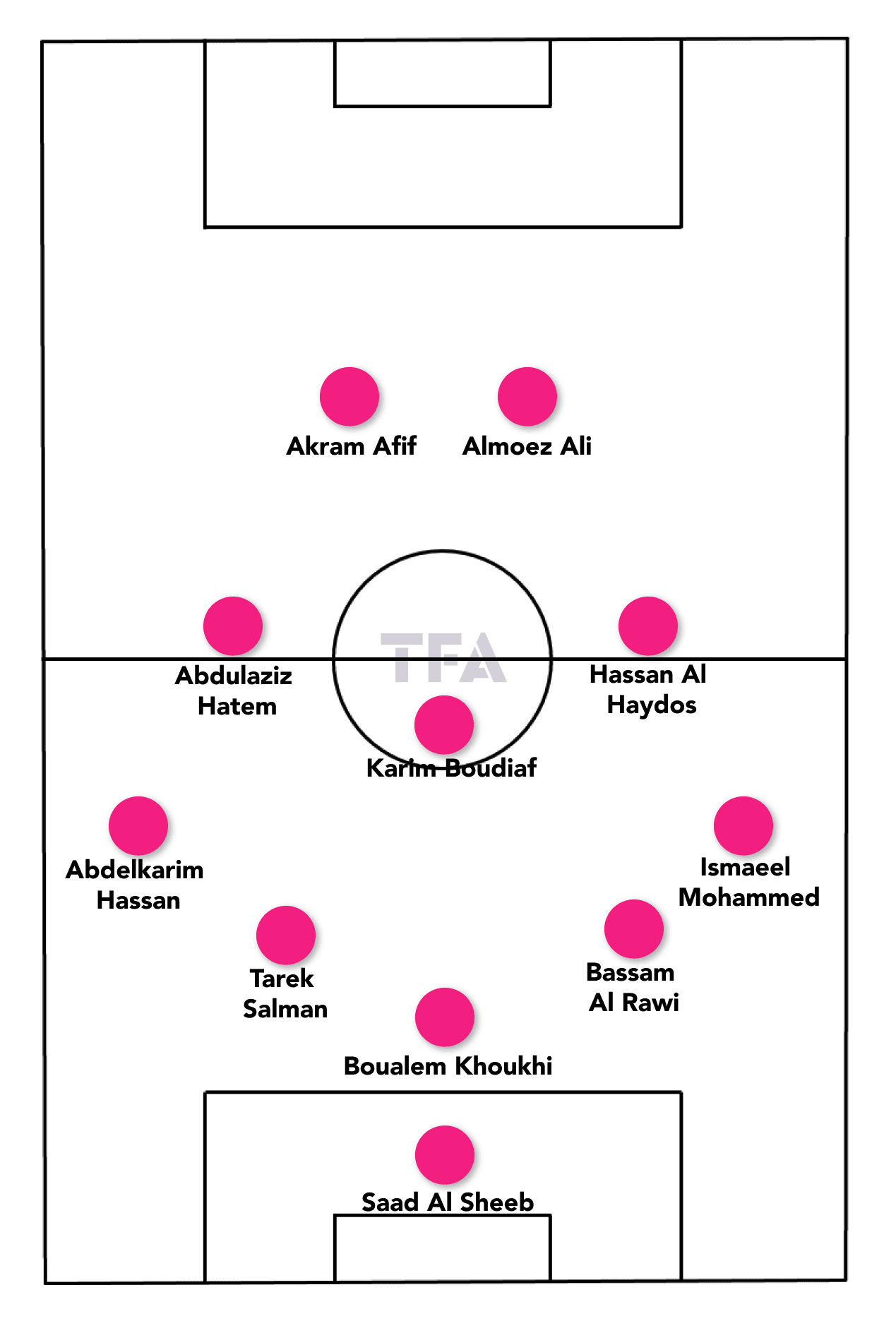
We predict the experienced Saad Al Sheeb, one of 13 Al Sadd players in the squad, to start between the sticks. Sánchez frequently rotates his goalkeepers, so it wouldn’t be a surprise to see Meshaal Barsham or Al Gharafa’s Yousef Hassan making an appearance. In the centre-back trio, Bassam Al-Rawi of Al Duhail will start on the right side. Midfielder-turned-defender Boualem Khoukhi, another one of many naturalised players after moving to Qatar, will start in the centre of the three.
The left side of the defence is less clear. Tarek Salman, a player with youth experience in Spain after time in the Aspire Academy, is a reliable option for Sánchez. Portugal-born Pedro Miguel has played across the backline and was crucial to Xavi’s dominance with Al Sadd. Abdelkarim Hassan, who had a loan spell with Belgium’s Aspire-owned club Eupen, has featured as the left-sided centre-back and left wing-back for Qatar. On the opposite flank, Ismaeel Mohammed will provide energy up and down the right wing.
In front of the defence, naturalised pivot player Karim Boudiaf of Al Duhail will balance the midfield and allow the two eights to advance. Al Rayyan’s Abdulaziz Hatem will shuttle between the boxes as an all-action midfielder. Meanwhile, Al Sadd’s Hassan Al Haydos will have a freer role, drifting wide and combining as more of an attacking midfielder.
Qatar’s strike partnership consists of their two best players; Akram Afif and Almoez Ali. During his time at the Aspire Academy, Afif had a spell in Spain, representing Sevilla and Villarreal’s youth teams. He began his senior career with Eupen in Belgium before rejoining Villarreal on a permanent deal.
Without a first-team appearance for The Yellow Submarine, Afif returned to Al Sadd after a successful loan. Ali also has European experience, in Austria, Belgium and Spain, but his best work has been with Al Duhail. Whilst Afif has the license to roam and provide overloads across the pitch, Ali will remain centrally as the focal point to occupy centre-backs.

Attacking Phase
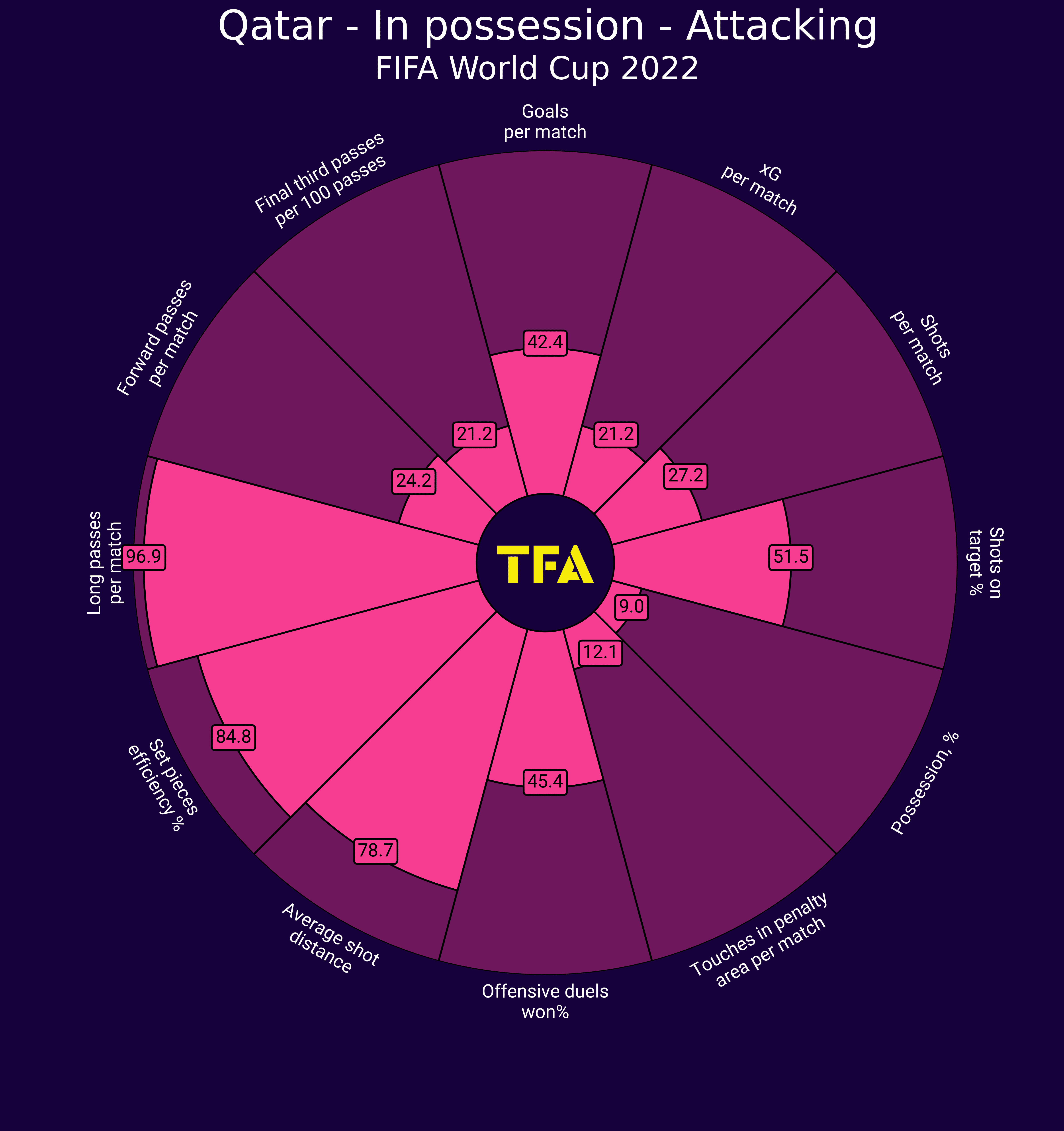
In possession, Qatar are not a ball-dominant side. In the last year, Félix Sánchez’s team have averaged 46.63% possession with their approach tending to focus on resisting pressure and fast-paced attacks. From the eight games in which Qatar have had less than 50% possession, they attempted more shots than their opponents in six of them. The Maroon average just 4.64 passes per possession, with nearly 13% of their passes being long passes. Despite having less possession, Qatar regularly attempt more long passes than their opponent.
From goal kicks, though, Sánchez’s side mainly play short. When playing under Sánchez, all three goalkeeper options of Meshaal Barsham, Saad Al Sheeb, and Yousef Hassan take the majority of their goal kicks short and generally attempt twice as many short passes per game as long passes. The short goal kicks are often two-yard passes to the central centre-back, Boualem Khoukhi.
The two wide centre-backs hold maximum width on the same horizontal line as Khoukhi, typically in line with the six-yard box. This peculiarly deep and wide positioning from the centre-backs also has them on the same vertical line as the wing-backs, creating suboptimal receiving angles for the wing-back if the wide centre-backs try to access the wing-backs.
However, the centre-backs’ wide positioning stretches the opposition’s front line. If opponents overemphasise central compactness, the wide centre-backs will be free to receive. But opponents tend to place their front two evenly between the Khoukhi and the wide centre-backs, thus giving Khoukhi time in possession. With the awkward centre-back positioning stretching the opposition’s front line, the passing lanes are expanded for Qatar’s central centre-back. As a result, they can find the dismarking midfielders or attackers with longer passes beyond the opposition’s first two lines of pressure.
This can, in essence, create Qatar’s threatening transitional moments from their own goal kicks by attracting opponents into Qatar’s defensive third before playing behind them to face their own goal. Boualem Khoukhi is capable of playing these longer passes, averaging 8.76 progressive passes per 90 with a strong accuracy of 77.27% for Al Sadd in the Qatar Stars League last season.
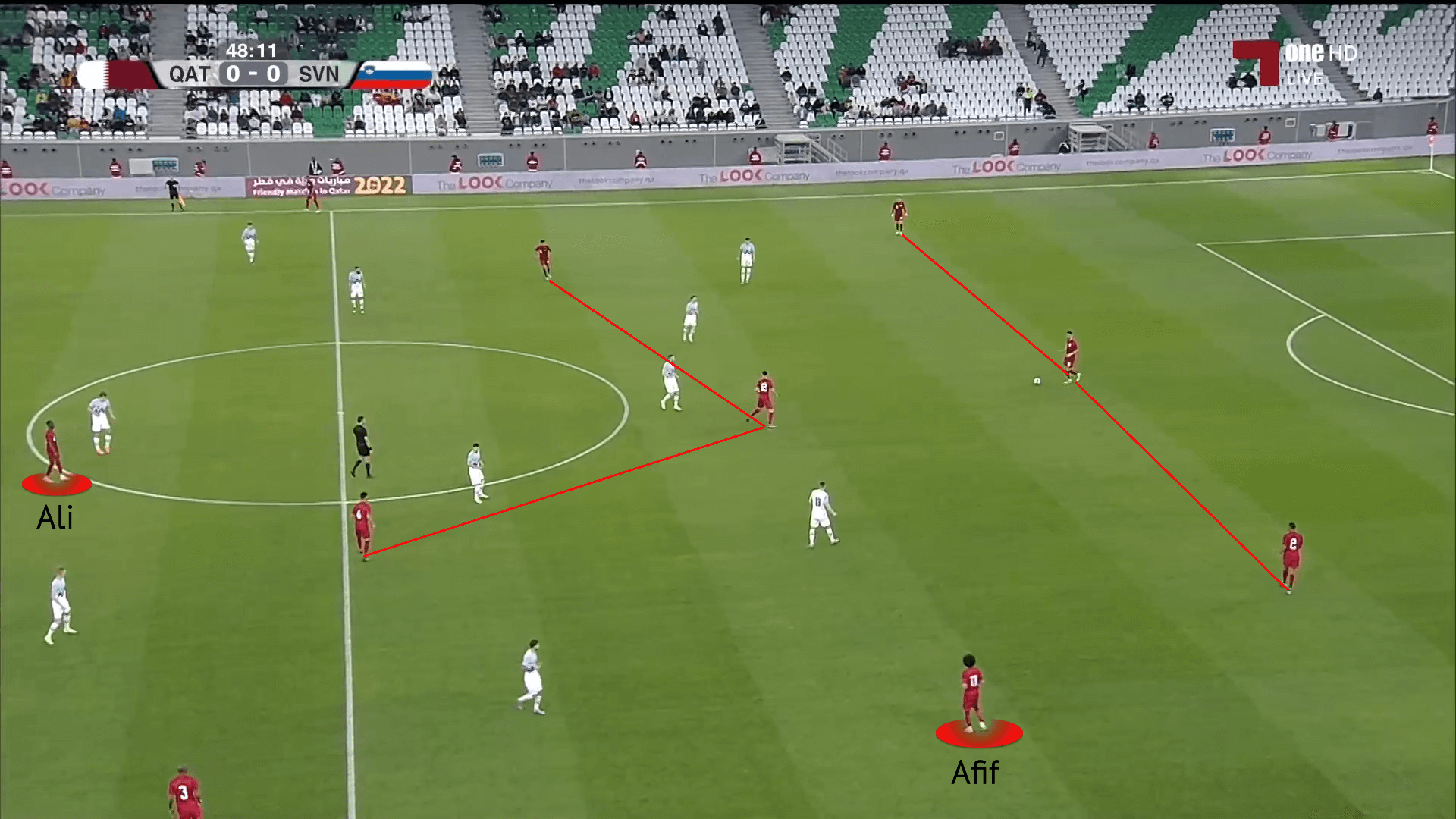
In the image above against Slovenia, we can see build-up similarities to Qatar’s shape from goal kicks. Khoukhi has possession as the central centre-back with the outside centre-backs continuing to take up wide positions. This wider positioning also facilitates the advancing movement of the two wing-backs, with Abdelkarim Hassan and Ismaeel Mohammed joining the front line at the top and bottom of the image.
Right centre-back Bassam Al Rawi is Qatar’s best ball-playing defender, retaining useful passing range to bypass opposition pressure or switch the point of attack from right to left.
With the two wing-backs pushing forward, the midfield three will remain ahead of the defence in the build-up phase rather than joining the forward line. The midfielders will have staggered positioning to provide different options and aid ball progression out of the defence. In the image above, Naif Al Hadhrami has drifted towards the right half-space between the Slovenia midfield and forward line, whereas Mohammed Waad is behind the Slovenia midfield.
These are positions that we can expect starters Hassan Al Haydos and Abdulaziz Hatem to occupy and rotate, with Al Haydos frequently drifting wide to the right. Pivot player Karim Boudiaf offers some technical security and ball retention but mainly leaves the riskier progressive actions for others.
Attacker Akram Afif is often given full freedom to roam and influence Qatar’s attacking play wherever. With a tendency to operate in and around the left half-space, Afif regularly drops into the midfield or unoccupied spaces to receive freely from the centre-backs.
As Qatar’s key player, Afif is the usual target for the Maroon’s attacks. However, his tendency to drop deep or wide to the left can leave striker Almoez Ali isolated. Learning from manager Hernán Crespo at Al Duhail before joining the national team camps, Ali is impressive with his back to goal given his isolated circumstances. He has a comfortable first touch and uses his body to resist pressure, whilst also offering accurate passing to build attacks.
Against the physical and defensive quality that Ecuador, Senegal, and the Netherlands possess, Ali will need more support to link up with at the World Cup.
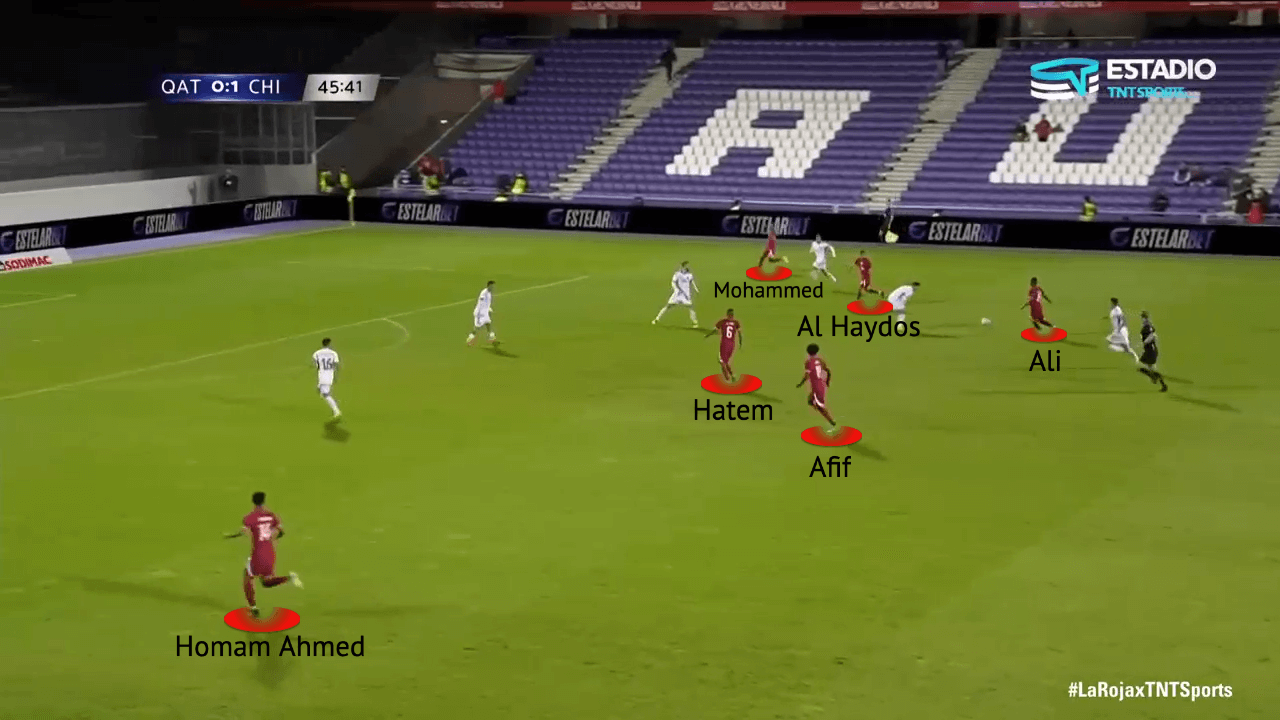
After a sustained spell of possession, Qatar’s attacking shape under Sánchez becomes more of a 3-1-6. With their counterattacking approach against stronger teams, we wouldn’t expect Qatar to sustain attacking pressure too often against World Cup quality but their shape naturally becomes a 3-1-6 during attacking transitions too.
With the two wing-backs remaining high and wide whilst Almoez Ali is central, support will push up from deep. Akram Afif will always find his way into the final third, hoping to craft shooting opportunities. The two central midfielders will also advance to make the front six, eventually providing some support for Ali’s link-up play.
Behind the front six, the pivot player and three centre-backs will sit back in rest defence. Karim Boudiaf will primarily be a recycling option with the two wide centre-backs looking to offer progression if necessary. Despite being right-footed, Tarek Salman is comfortable anywhere across the back three, but he always looks to open up and play the ball infield.
Abdelkarim Hassan is very forward-thinking, looking to carry into the midfield and break lines. However, his technical deficiencies regarding heavy touches and inconsistent weight of pass can be punished by quality opponents when deployed at centre-back, in particular.
Defensive Phase
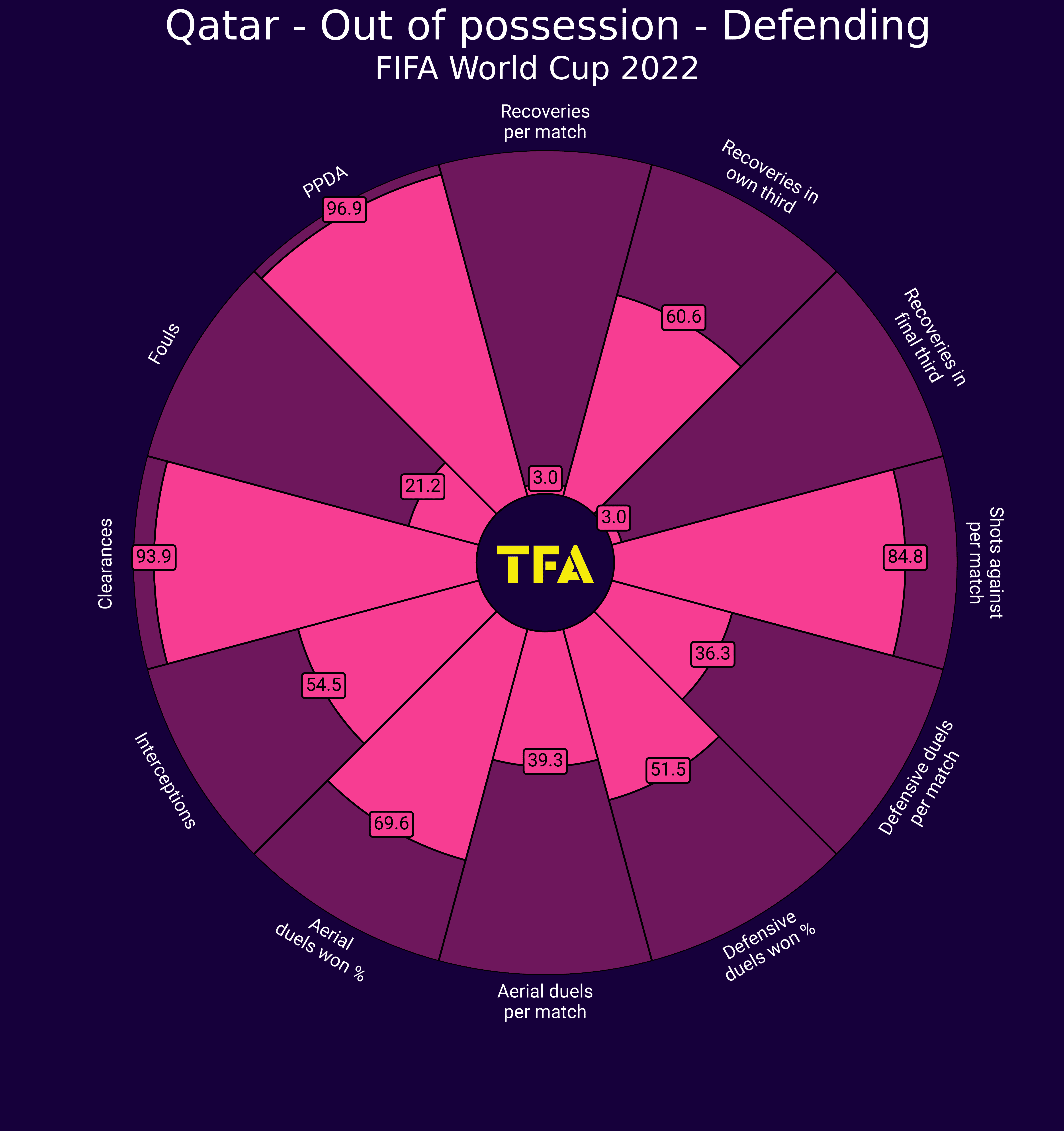
Out of possession, Félix Sánchez sets Qatar up to defend in a 5-3-2. The two wing-backs are attached to the defensive line to create a flat five. The wing-backs generally only move into the wide areas when the opposition winger is receiving by the touchline.
Due to the congested space in central areas from the back five and midfield three, their overloads allow the centre-backs to man-mark an opposition attacker that is dropping off. However, once the attacker travels in front of the Qatar midfield, the centre-back will move back into position.
An example of this can be seen in the figure below against Chile. Former Arsenal attacker Alexis Sánchez has dropped away from right centre-back Bassam Al Rawi, who initially followed Sánchez. Receiving off the centre-backs, Sánchez has possession in the left half-space and immediately attracts pressure from Qatar’s ball-side midfielder Hassan Al Haydos.
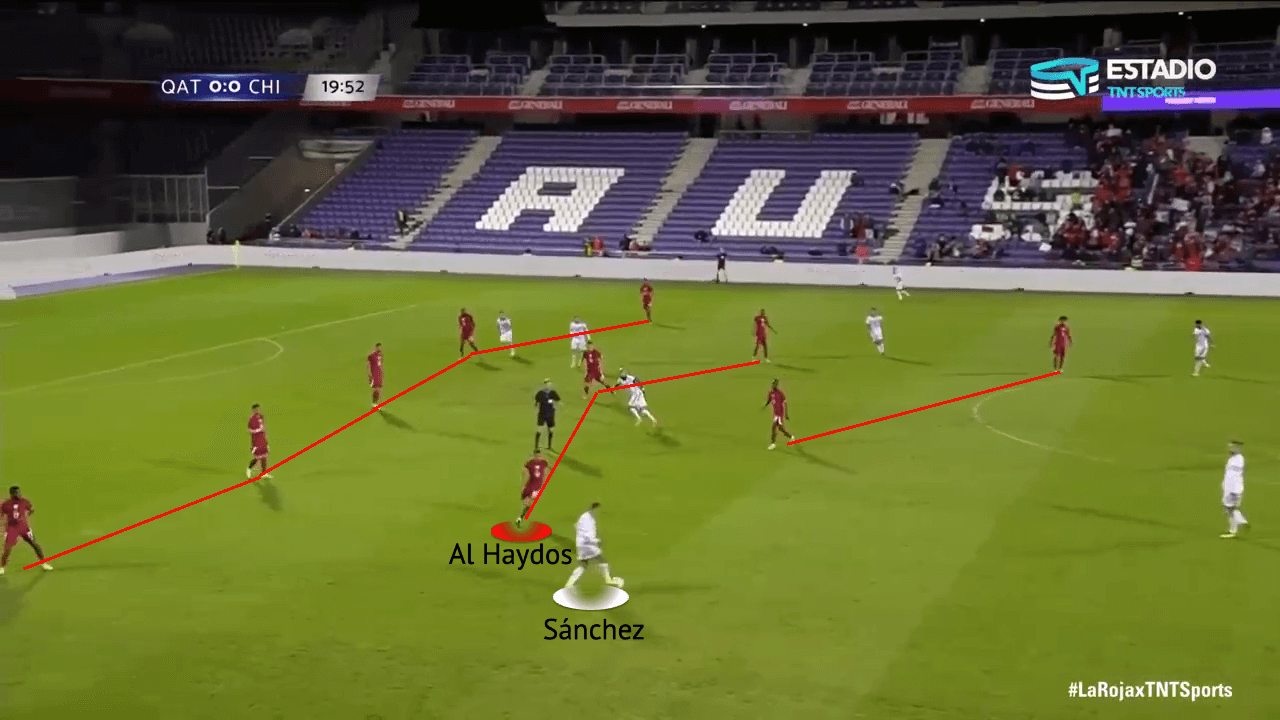
When inside the defensive third, the wing-backs will stay in the defensive line, practically pinned back by the opponent’s wingers. Pairing this with the central midfielders’ narrow positioning, Qatar allows lots of space in the wide areas. Attacking players, such as Alexis Sánchez, often drop to receive on the half-turn but the most effective way of punishing this defensive structure is with the use of the defenders.
Qatar’s ball-side midfielder will move wide to press the ball carrier when they begin to enter the final third. Striker Almoez Ali is primarily responsible for blocking the opposition pivot player but will drop even further into the vacated space from the pressing midfielder.
Akram Afif lacks defensive work rate, typically just roaming to positions that could threaten in attacking transitions. This allows the opposition’s defenders time on the ball with the opportunity to step into midfield. Daley Blind’s exceptional passing ability and Nathan Aké’s assured progression have the quality to penetrate Qatar’s midfield and retain numbers in the front line. Senegal and Ecuador also have defenders that can accelerate attacks and break through Qatar’s structure, like Pape Abou Cissé and William Pacho.
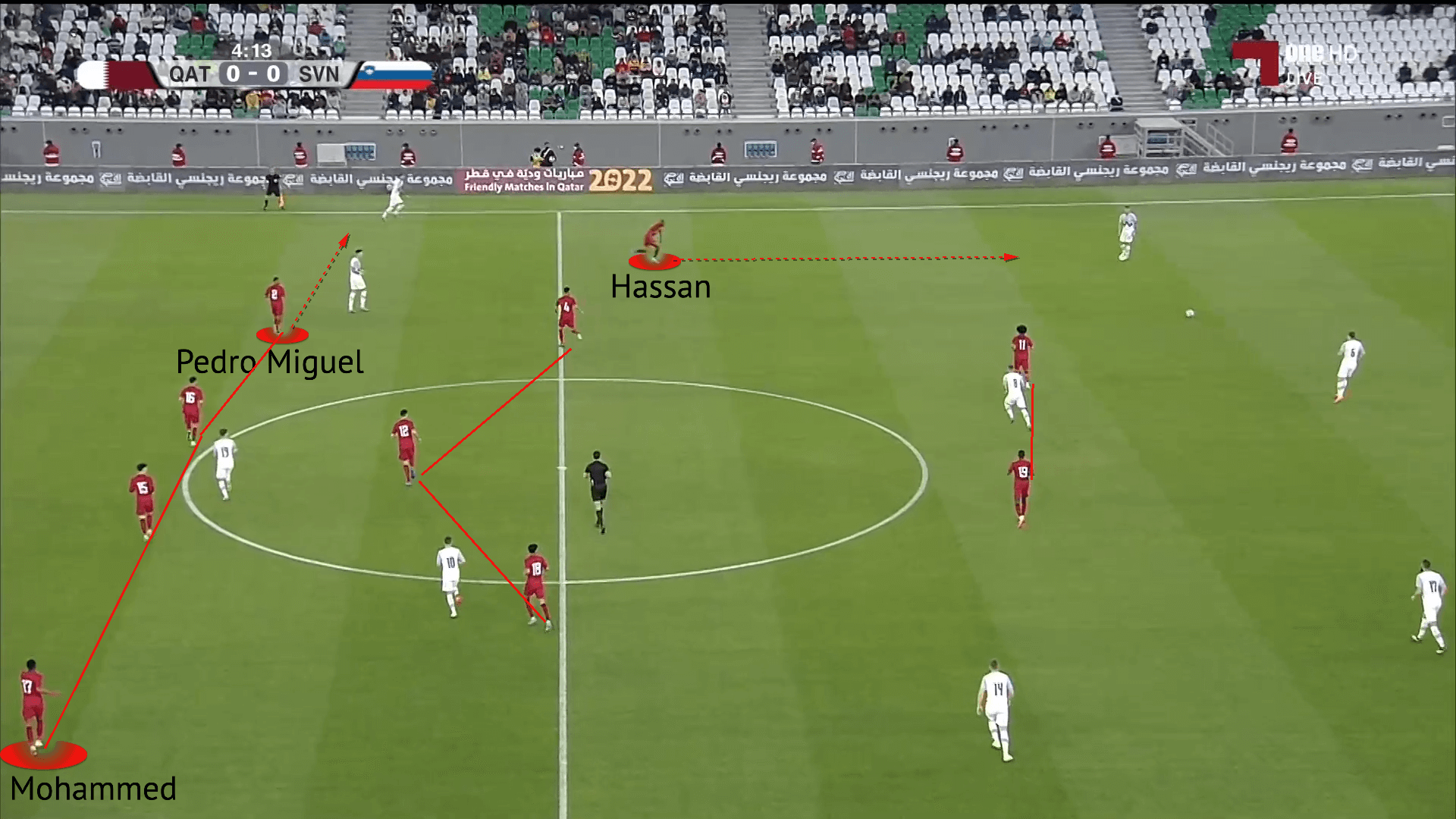
When the opposition have possession in deeper areas, attempting to progress into the final third, Qatar’s wing-backs occasionally jump out of the defensive line to press the opponent’s full-backs. This strategy requires immense fitness levels from the wing-backs, sprinting after anticipating the pass wide to pressure the first touch. Qatar’s wing-back will look to prevent a pass down the line and force play backwards, with the ball-side attacker cutting out access to the pivot. The remaining four defenders will naturally shift across to provide cover and balance.
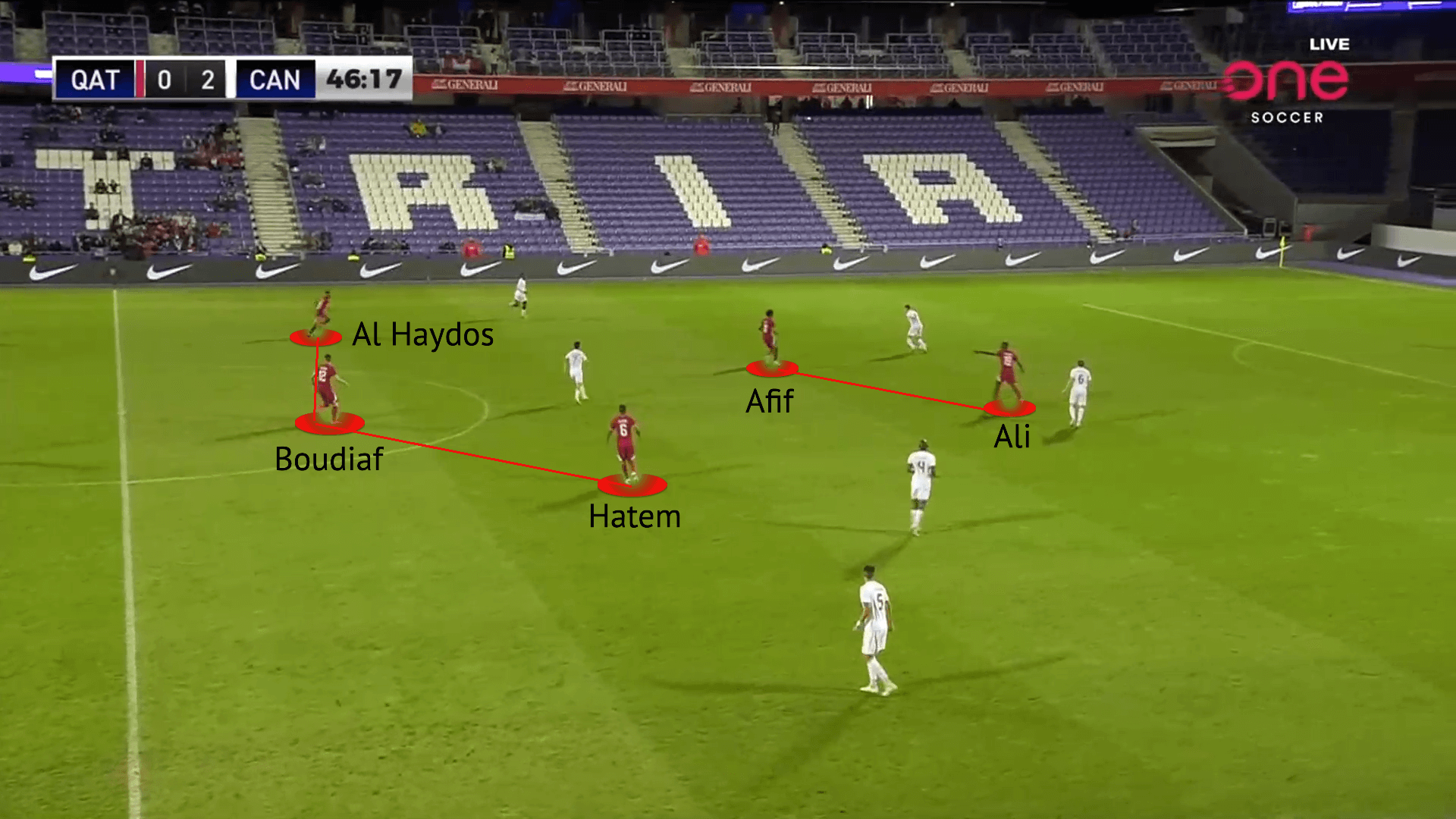
Qatar’s out-of-possession focus is to absorb pressure in their defensive structure, limiting openings and space in and around the defensive line whilst conceding spaces in deeper areas. As a result, Félix Sánchez’s side on average allow the opposition to play 23.73 passes per defensive action. This is a stark contrast from the high-pressing approaches of Senegal, Ecuador and the Netherlands. Striker Almoez Ali is always a willing presser of the backline and goalkeeper in the final third and for backwards passes.
If Qatar do engage in a high press against the opposition’s build-up, they will press out of their 5-3-2 shape. The front two will focus on pressing the centre-back in possession whilst keeping the pivot player in their cover shadow. The midfield three will push up to condense the space and pressure ball reception into the midfielders or full-backs. If the winger drops back to create a new passing angle, Qatar’s wing-back will follow and remain touch-tight.
Transitions
With their sit-back and counterattack approach, attacking transitions are crucial to Qatar’s success. In the last year, 38.7% of Qatar’s counterattacks have ended in shots, averaging at over 1.5 per game, which is a decent efficiency for Félix Sánchez’s side.
Ecuador and the Netherlands are generally quite good at limiting opposition counterattacks, with Senegal potentially the opponent Qatar will have the most success in attacking transitions against. Nevertheless, the Maroon will certainly threaten with counterattacks against any opponent, and it would be required to progress beyond the group stage.
Qatar’s 5-0 win against the UAE in the FIFA Arab Cup quarter-finals epitomises their game plan. Sánchez’s team were 5-0 up at half-time with just 25.8% possession after devastating directness in attacking transitions.
The opening goal was scored six seconds after regaining possession and the third goal was the result of a penalty won five seconds after winning possession. The fourth goal was the aforementioned semi-transition situation, attracting opponents forward from short goal kicks, with a goal scored ten seconds after a quick free-kick on the edge of the Qatar box. The fifth goal hit the back of the net five seconds after regaining possession.
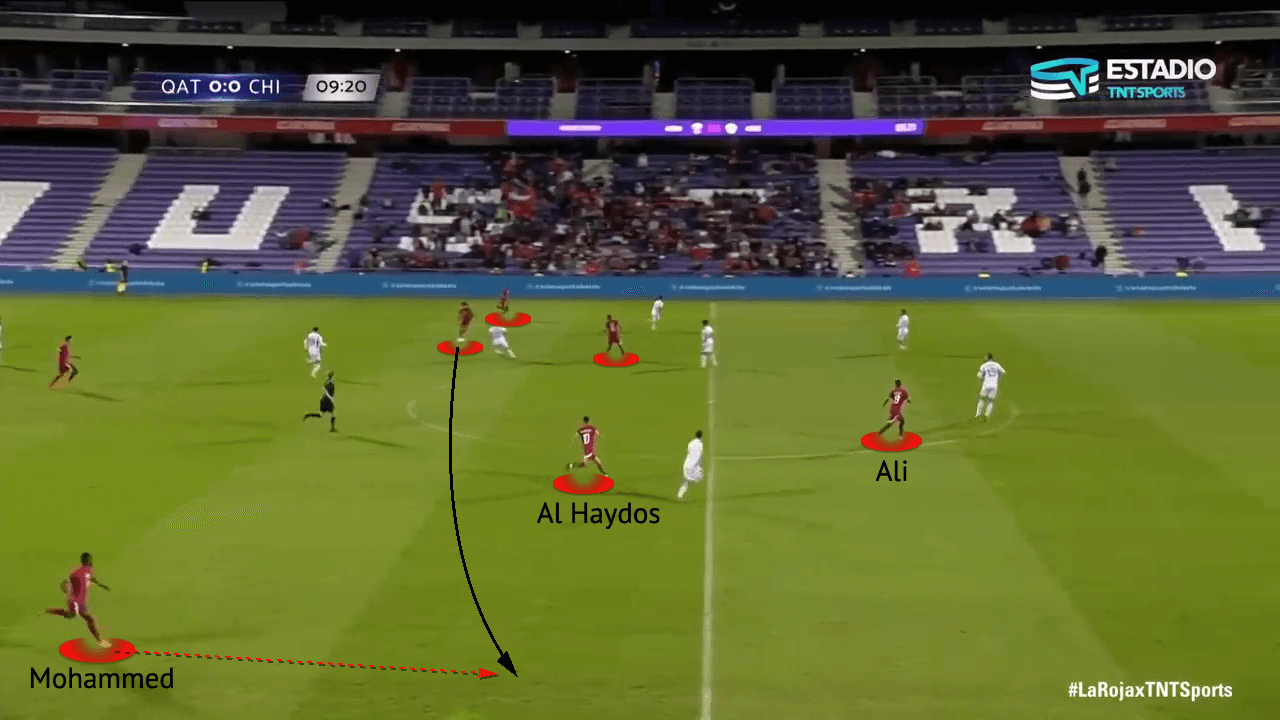
The image is an example of Qatar’s counterattacks against Chile. Akram Afif, the player in possession, is the primary receiver of forward passes to trigger counterattacks as a talented ball carrier. Striker Almoez Ali remains centrally up against the opposition’s defensive line. The two central midfielders will also push up to support, typically targeting eventual shooting opportunities on the edge of the box.
With Afif’s tendency to drift towards the left, sometimes only the right wing-back will join the counterattack on the far side. However, often both wing-backs will bolt up the wing and facilitate Afif’s natural dribbling infield off the left. As a result, Qatar’s pivot player and three centre-backs stay back to provide balance.
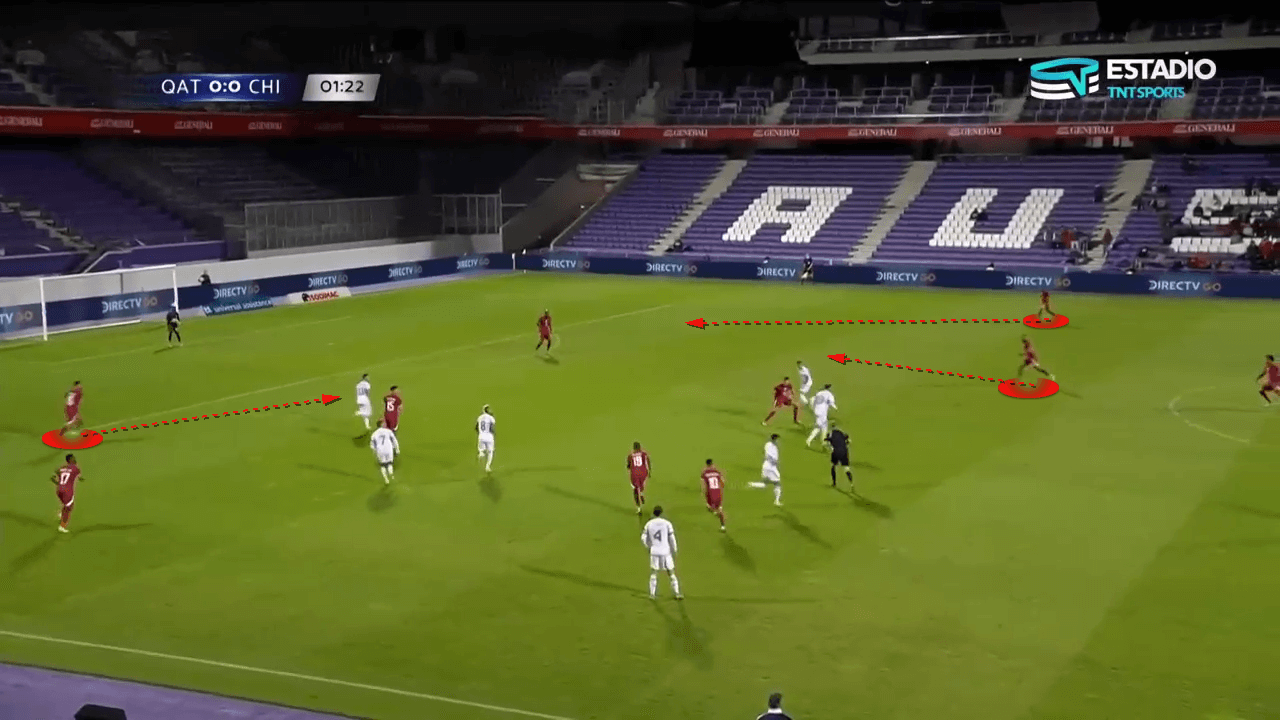
In defensive transitions, Qatar have less of a focus on counter-pressing with their intentions to rush back into a solid defensive shape. One player will pressure the opposition player in possession to delay progression. The defensively aware attacker Almoez Ali may occasionally drop into any gaps in midfield and sustain central compactness until teammates get back into a narrow structure from an expansive attacking shape.
Sánchez may combat the ruthless attacking quality at the World Cup by keeping one wing-back deeper or by limiting central midfielder Abdulaziz Hatem’s runs forward.
Attackers
Qatar’s starting striker partnership of Almoez Ali and Akram Afif contains their best two players. In possession, it is clear that Félix Sánchez wants them to receive the ball as frequently as possible. Akram Afif has the freedom to drop during the build-up phase to receive in space off the centre-backs, whilst also having the license in rest-attack to drift into areas where he thinks Qatar can best progress and penetrate.
Almoez Ali is much more of a selfless player. Willing to take on Afif’s defensive workload whilst remaining compact, his attacking game is also really strong. He can resist pressure with his back to goal and find supporting teammates with accuracy, whilst registering 50 goals and 47 assists in 163 games for Al Duhail.
Off the bench, Al Gharafa’s Ahmed Alaaeldin is a nuisance for opposition defences. He doesn’t quite have Ali’s quality with his back to goal, but the Egypt-born striker can cause chaos off long balls. He can run the channels but his runs in behind defences offer something different for the Maroon. Despite his dreadful goalscoring record for the Qatar national team, scoring just once in 46 caps mostly off the bench, Alaaeldin has displayed some composed finishing for Al Gharafa.
Midfielders
Qatar’s expected starting midfield of pivot player Karim Boudiaf, box-to-box midfielder Abdulaziz Hatem and attacking midfielder Hassan Al Haydos has a wealth of experience and balanced technical qualities. All three are willing to cover ground defensively, with Boudiaf tending to sit in front and protect the defence with his aerial and ground duelling ability. Al Sadd’s Al Haydos provides riskier attacking intent and has incredible chemistry with key player Akram Afif.
Assim Madibo of Al Duhail is the likely replacement for Boudiaf as the defensive midfielder and is another player to have graduated from the Aspire Academy before having spells in Austria, Spain and Belgium. Al Sadd’s Mohammed Waad is the swap for left-sided central midfielder Hatem, although weaker going forwards he has better defensive fundamentals.
Ali Assadalla offers a bit more technical security than the other midfielders, at the expense of Al Haydos’ creativity and Hatem’s duelling, but is a useful option for both roles. Assadalla can also operate as the width holder if needed, a common role of his at Al Sadd.
Defenders
We expect Abdelkarim Hassan, Bassam Al Rawi and Boualem Khoukhi to be guaranteed starters for Qatar at the World Cup, but manager Félix Sánchez has a few options to complete the back five. Left-footed Hassan has been deployed as the left-sided centre-back and left wing-back.
Meanwhile, Al Gharafa’s Homam Ahmed is a suitable, consistent player for the left wing-back role as Hassan’s back-up or alongside Hassan. Portugal-born Pedro Miguel has also played left centre-back but has spent most of his career playing at right-back. Khoukhi and Al Rawi will start in the centre and right of the three centre-backs respectively, with Tarek Salman another option for the left centre-back spot.
Key Player
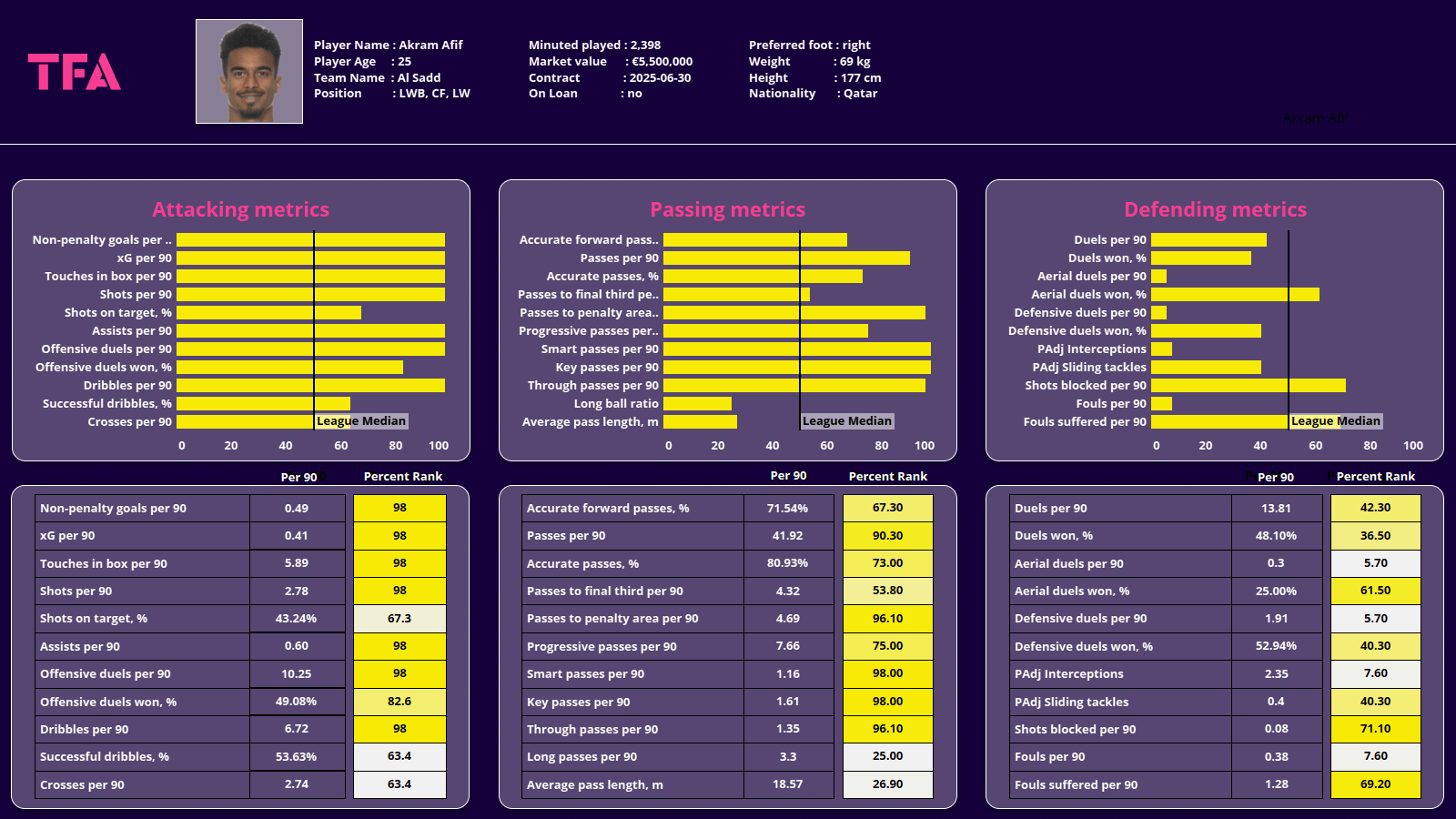
Akram Afif (177cm/5’10”, 69kg/152lbs) is a right-footed attacker at the heart of Qatar’s attacking play. The 2019 Asian Footballer of the Year often operates as the left winger for Qatari club Al Sadd but Félix Sánchez deploys Afif in a strike partnership with Almoez Ali.
As mentioned earlier, Afif is allowed to drift into different positions to receive possession and influence the game as much as possible. He can take too many touches in deeper phases, which will be punished on the biggest stage and was punished by Chile’s Alexis Sánchez in September.
He is essential to Qatar’s counterattacks with his quality ball manipulation and ability to skip past challenges making him the target for attacking transitions. His responsibilities also include set pieces, with his eye-catching afro regularly seen over the Maroon’s free-kicks and corners.
Tournament Prediction
As the second-lowest ranked nation at the FIFA World Cup, hosts Qatar will be dreaming of causing an upset to progress into the knockout stages in their first-ever finals appearance. Facing Ecuador in the tournament’s opening fixture, manager Félix Sánchez will be fantasising about earning three points against the group’s perceived second-weakest side to kick off a memorable tournament for the Maroon.
However, Ecuador are full of emerging talents, with many already making the jump to Europe. Brighton duo Moisés Caicedo and Pervis Estupiñán are well-rounded to support Bayer Leverkusen centre-back Piero Hincapié in defence and electric winger Gonzalo Plata in attack.
In Senegal and the Netherlands, Qatar faces two powerhouses of their continents. Senegal arrive in Qatar as the reigning AFCON champions and qualified for the World Cup by beating Mohamed Salah’s Egypt in a dramatic penalty shoot-out. With two established, world-class stars in centre-back Kalidou Koulibaly and Bayern Munich attacker Sadio Mané, Qatar will be challenged more than ever. And things may only get worse for Sánchez’s side when they line up against the Netherlands, whose form has them as one of the potential World Cup winners.
With the drama of a tournament opening fixture against Ecuador, the potential counterattacks against Senegal and facing the Netherlands when the Oranje may have already qualified for the next round, maybe Qatar could surprise and progress. That is, however, unlikely, with the quality of these three teams much greater than Qatar’s. In reality, one point from the group stage would be better than most people would expect, with three points being a remarkable achievement for the Arab nation. Either way, Qatar will be looking to put on a show as hosts of the world’s most viewed sporting event.

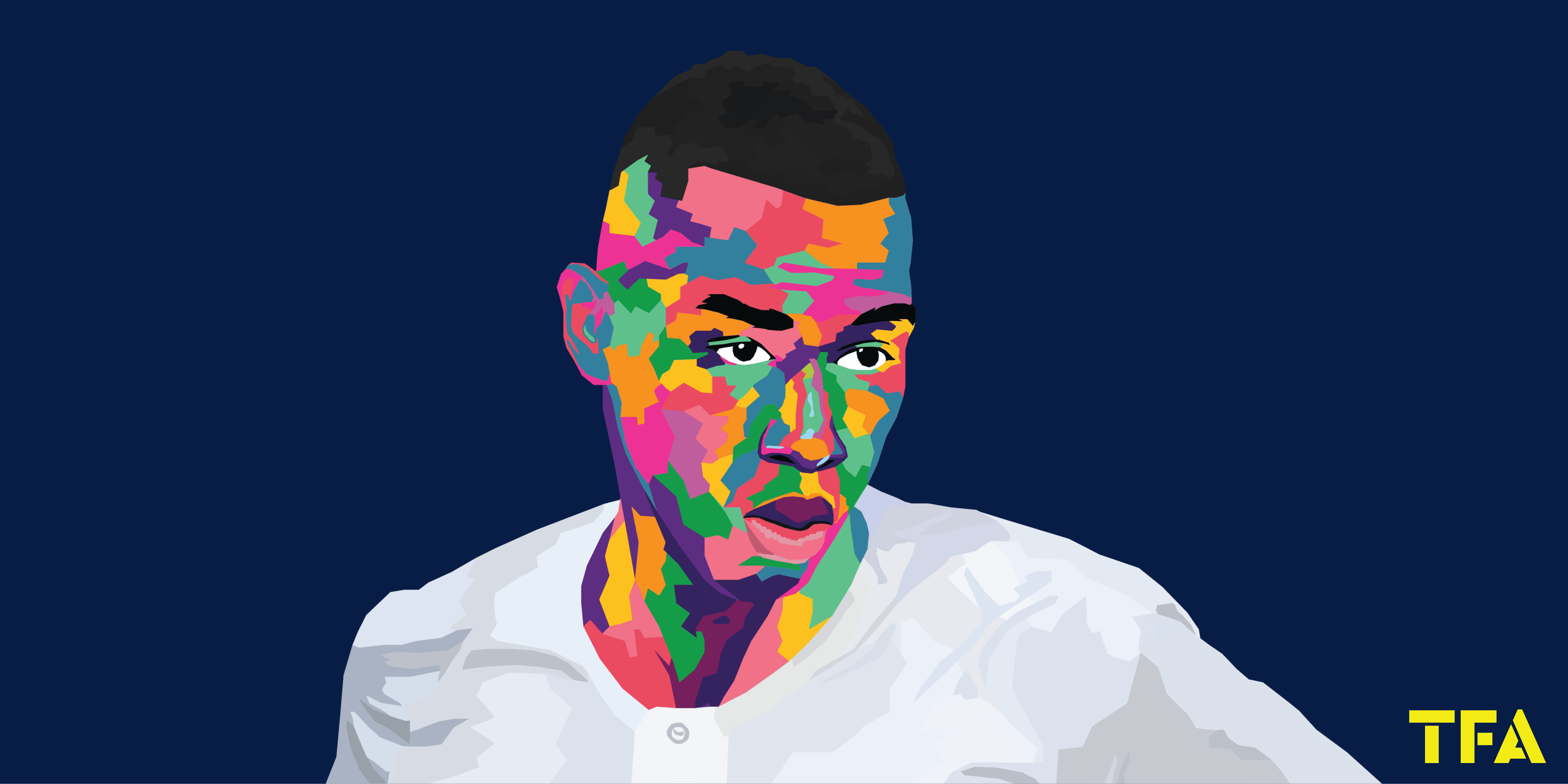




Comments